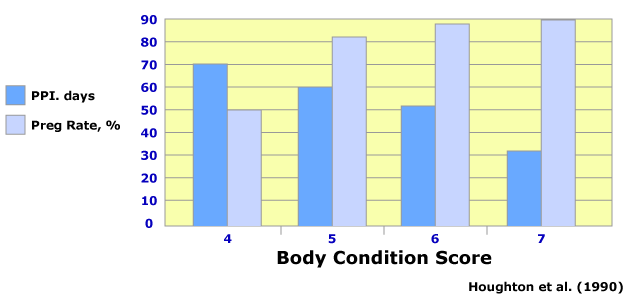Previous Page | Right click this page to print.
Body Condition Score
Body condition score is important in beef cattle and it is a subjective measure of the degree of body reserves or fat stores that the animals have. It is appraised based upon apparent external fat covering. We generally body condition the animals over the hooks and pins and tailhead area and over the spine or through the withers. It is based on a 1 to 9 scoring system. Generally, we want to have cows in a condition score of five. So moderate condition at calving and at breeding. Research has looked at different body condition scores and the effect on postpartum interval, or the interval between calving and conception, and also pregnancy rate.
The following table depicts the effect of body condition score of four levels, four, five, six and seven, on postpartum interval and pregnancy rate.

We see that at a condition score of four, which is less than optimal, postpartum interval in days is about 70 and the pregnancy rate is about 50%. There is a dramatic improvement actually when animals move up to a condition score of five. Postpartum interval decreases by 10 days from 70 to 60 and pregnancy rate increases from 50 to 80%. As we increase condition score, you will notice that the postpartum interval does decrease from 70 to 60 to 50 at a condition score of six and even up to 30 at a condition score of seven. It is almost a linear decrease in postpartum interval as body condition score increases. Notice pregnancy rate, pregnancy rate does not increase as fast as we go from a condition score of five to six to seven. Based on this graph, which would be the optimal animal, based simply on postpartum interval and pregnancy rate? It would be an animal in the condition score of seven. However, the most economical score would be that of a five because our increase in pregnancy rate is not as great as we move to a six and a seven to make up for the difference in cost associated with getting that animal to a higher condition score.
The next table depicts what level of condition the animals were in and whether they were increasing or maintaining condition score.
BCS
Status |
Preg Rate (%) |
|---|---|
= 5 & decreasing
BCS |
69 |
< 5 & increasing
BCS |
100 |
5 & maintaining
BCS |
100 |
> 5 & decreasing
BCS |
94 |
= 5 & increasing
BCS |
75 |
Houghton et al. (1990)
First, is an animal that is less than a five and is losing body condition
or losing weight and the preg weight was 69. Next, is an animal that is
less than five and is gaining weight and they had a pregnancy rate of
100%. The next group of animals, were at a five and maintaining condition
and they had a pregnancy rate of 100%. The next group of animals, were
greater than five and they were losing condition score and they had a
pregnancy rate of 94%. And our last group of animals, were animals that
were greater than or equal to five and increasing in body condition score
with a pregnancy rate of 75%. So the most optimal, base upon pregnancy
rate and economics, would be cows that were at a condition score of five
and maintaining body condition. You can also get some improvements in
pregnancy rate of thin animals or animals that are less than five, if
they are actually gaining weight during this period. We can see that animals
that are less than five that are losing body weight have less than optimal
preg rates and animals that are even greater than or equal to five and
that are either increasing or decreasing body condition score have less
than optimal pregnancy rates.
Previous Page | Right click this page to print.